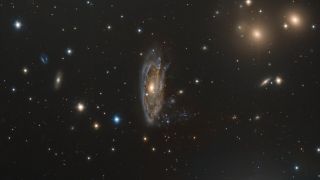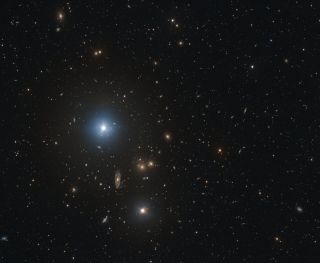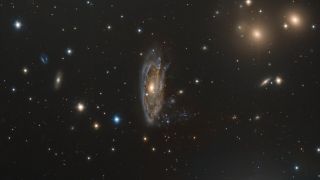A galaxy is robbed of its gas and stars in a new image from the European Southern Observatory (ESO).
The spiral galaxy, called NGC 3312, lies within a large cluster known as Hydra I. Located over 160 million light-years from Earth, this cluster contains hundreds of galaxies, the largest of which is NGC 3312.
Using the ESO’s VLT Survey Telescope (VST) at the Paranal Observatory in the Atacama Desert of northern Chile, astronomers captured an up-close view of the spiral galaxy, which appears to be “spilling its contents into the cosmos around it,” ESO officials said in a statement releasing the new image.

NGC 3312 is located front and center in the new image, surrounded by bright stars and galaxies. A smudge of interstellar material can be seen at the lower right of the galaxy, suggesting it is being stripped from the galaxy as it falls toward the center of the cluster — a process known as ram pressure stripping.
Related: World’s largest visible light telescope spies a galaxy cluster warping spacetime
“This happens when a galaxy moves through a dense fluid, like the hot gas suspended between galaxies in a cluster,” ESO officials said in the statement. “This hot gas drags against the colder gas on the outer shell of the galaxy, ‘pulling’ it off of the galaxy and causing it to leak into the cosmos. This cold gas is the raw material out of which stars form, meaning galaxies losing gas this way risk a dwindling stellar population.”
Over time, as more and more gas is stripped from the galaxy, it can form long tendrils of trailing gas. As a result, galaxies like NGC 3312 that fall victim to such acts of cosmic robbery are often nicknamed jellyfish galaxies.

Related Stories:
For perspective, the ESO also shared a zoomed-out view of the Hydra I cluster. The spiral galaxy NGC 3312 can be found between two bright points in the image: Beneath a large blue star captured at the center-left of the image and above a slightly smaller stellar neighbor with a golden glow, located to the bottom right of the galaxy.
This wide-field view captures a number of galaxies, showcasing the vast nature of the Hydra I cluster, which contains a whopping 157 bright galaxies, whose evolution may also be impacted by strong gravitational influences within the cluster.
Ram pressure stripping “is just one of the many astronomical processes that make pictures of the universe so varied and captivating,” ESO officials said in the statement.



